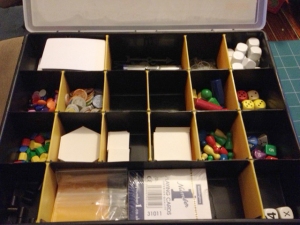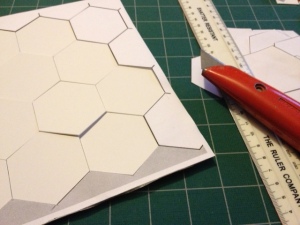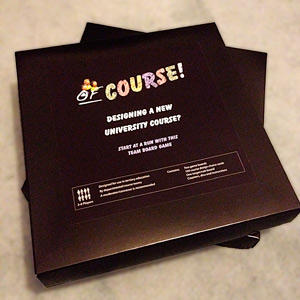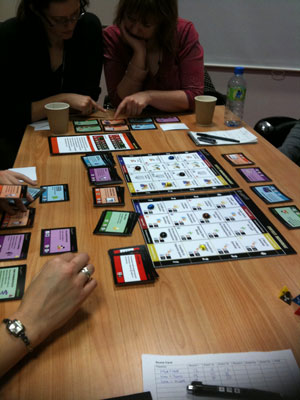 Over the Christmas break I’ve been catching up with some of the games news from the latter end of 2011 – and Risk Legacy caught my eye, as it did when I first heard about the idea. Finally release just before Christmas in the US, this new version of Risk changes the nature of boardgames in a rather exciting way. Up until now, every time you open a boardgame the scene is set to zero: the board and pieces begin at the start just as they did in the previous game (unless you have small children who ‘modify’ the contents in their own unique way). But the designers of Risk Legacy played on the idea that – in reality – battles, feuds and alliances will be remembered by regular players each time a new game is played, and might therefore influence gameplay in a continuum, rather than a constant restart (there’s an interesting interview with the game’s designers in The Escapist).
Over the Christmas break I’ve been catching up with some of the games news from the latter end of 2011 – and Risk Legacy caught my eye, as it did when I first heard about the idea. Finally release just before Christmas in the US, this new version of Risk changes the nature of boardgames in a rather exciting way. Up until now, every time you open a boardgame the scene is set to zero: the board and pieces begin at the start just as they did in the previous game (unless you have small children who ‘modify’ the contents in their own unique way). But the designers of Risk Legacy played on the idea that – in reality – battles, feuds and alliances will be remembered by regular players each time a new game is played, and might therefore influence gameplay in a continuum, rather than a constant restart (there’s an interesting interview with the game’s designers in The Escapist).
 The new version of Risk therefore comes with stickers, special rules, secret pockets and other tricks which make permanent changes to the game. If you make a choice between two cards, for example, the other card is destroyed. Literally (from the rulebook: “If a card is DESTROYED, it is removed from the game permanently. Rip it up. Throw it in the trash.”). Other changes affect the board or the rules permanently – and they come into play when certain conditions are met, such as ‘open the first time a faction is eliminated from the game’. Plus, deliciously intriguingly, one envelope secured to the box base labelled ‘Do not open. Ever’.
The new version of Risk therefore comes with stickers, special rules, secret pockets and other tricks which make permanent changes to the game. If you make a choice between two cards, for example, the other card is destroyed. Literally (from the rulebook: “If a card is DESTROYED, it is removed from the game permanently. Rip it up. Throw it in the trash.”). Other changes affect the board or the rules permanently – and they come into play when certain conditions are met, such as ‘open the first time a faction is eliminated from the game’. Plus, deliciously intriguingly, one envelope secured to the box base labelled ‘Do not open. Ever’.
Winners in the game get to create special conditions in the following game (such as founding a new major city) whilst losers also carry certain conditions into their next game too. All of this means that the game becomes a campaign, rather than a one-off scenario, where player actions affect not only the current game, but will have repercussions for future games too.
This innovative approach is not for everyone, of course – many players (particularly beginners) like boardgames precisely because they can write off a poor loss by starting a new game afresh, each game providing a fixed structure for developing a beginner’s gameplay: an essential time-honoured learning curve. And some who like the aesthetics of board games will be appalled at the idea of destroying or defacing cards or boards – designer Lewis Pulsipher has attacked this aspect of Risk Legacy. It is also pretty obvious that you need regular players to get the most out of Risk Legacy – a game-loving family, or games group. But all this aside, the idea and possibilities are fascinating both for future boardgames, and for education.
The traditional method of learning a boardgame, outlined above, carries a number of similarities with the way we tend to teach courses in higher education: we tend to explain complex subject concepts in the same way each year to new students, and (particularly in practical subjects) rely on the students to practice those concepts with real-world examples or conditions: multiple case-studies or assignments giving students a new chance in each case to develop and consolidate their understanding. The problems with this approach tend to be at the start, when students with a range of background experience are taught key concepts in the same way and at the same level; differential understanding then leads through to poorer or greater application of the knowledge in later exercises or assignments.
Experiential education tries to solve this problem by designing the teaching and learning around students’ existing knowledge, so that each student is learning on their own trajectory: it is, however, difficult and time-consuming to achieve – particularly with large numbers of students. The approach used in Risk Legacy might, though, be of interest here: the idea that students carry knowledge and decisions between each learning module, case study or assignment – and the modules or assignments themselves actually change based on those ‘carried forward’ conditions. Educational methods such as ipsative assessment (see Hughes, Okumoto & Crawford 2010) already utilise this approach, but are not widespread and suffer from the same problems of scalability for large student numbers. Maybe more scalable approaches could be used which allow students to carry conditions and effects through a number of case studies or exercises though, leaving assessments largely unchanged but altering the conditions and learning paths each student takes to their goal. In effect, turning discrete learning scenarios into a longer-term learning campaign.







